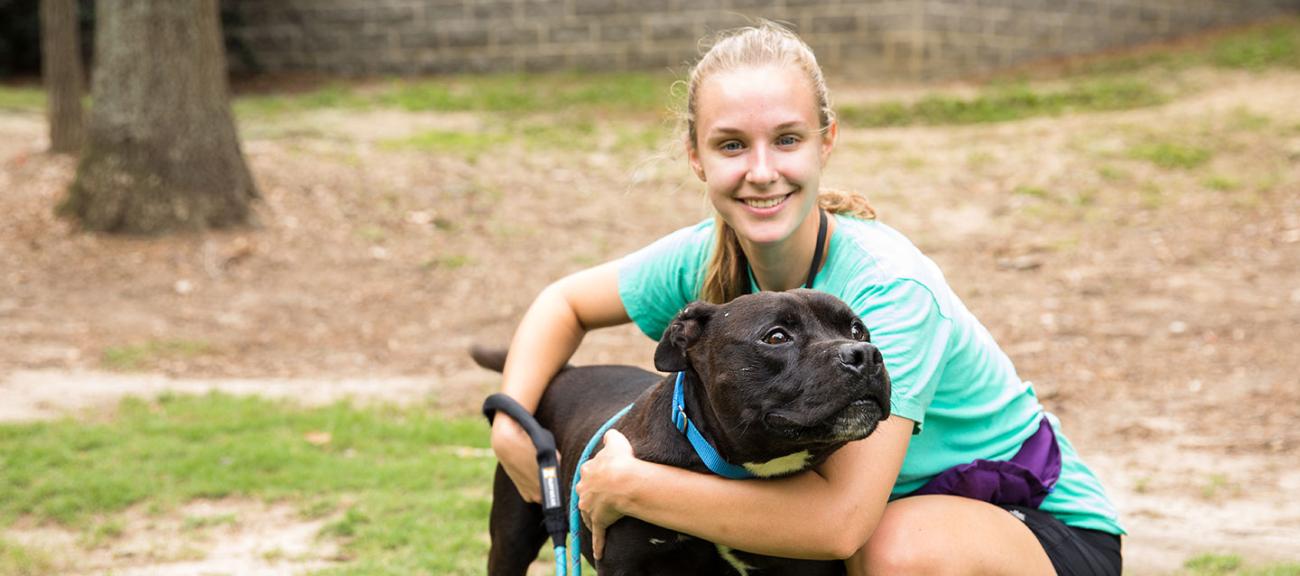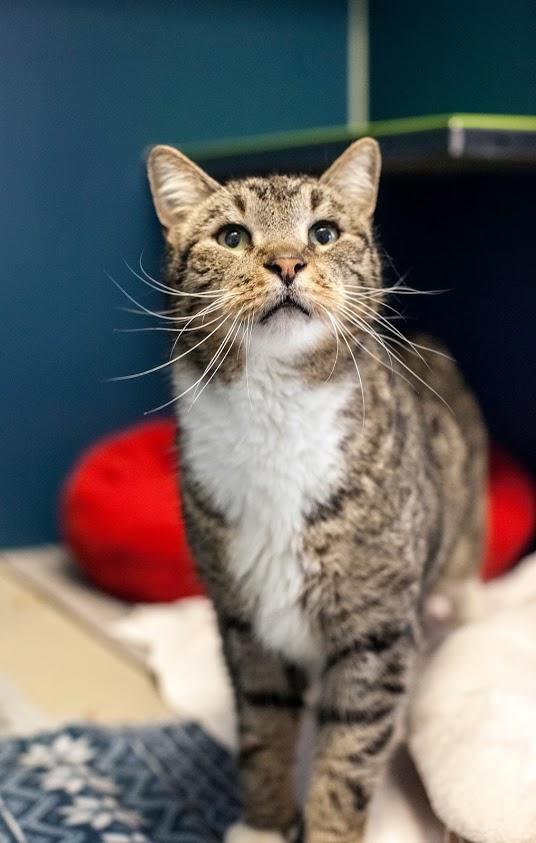
Introducing Dogs to Dogs
Is Your Current Dog Ready?

Before bringing a second dog home, assess whether or not this will enrich your current dog's life. Your dog may be a good candidate for having a roommate, if:
- Your dog has successfully shared space with (lived with) other dogs, in the past.
- Your dog is generally social and friendly with other dogs.
- You have had your dog for longer than 4-6 weeks and the dog is acclimated, comfortable and relaxed at home.
- Your dog does not have any current behavior issues that may be exacerbated by a second dog, including: resource guarding, poor impulse control or fearful behavior.
- Your dog does not guard resources (food, bones, treat, toys, beds, people, etc.) from other dogs by tensing, freezing, growling or snapping.
(Information courtesy of San Diego Humane Society)
Dog to Dog Introductions
- Begin with both dogs leashed, with separate handlers in a "neutral" space such as a walk in the neighborhood.
- Find a comfortable distance between both dogs (roughly 25-30 feet), where they can observe one another without becoming reactive and/or aren't pulling together to greet.
- Go for a walk! While still maintaining a distance, take turns letting one dog trail the other to gather information (smells from the scent glands between paw pads left on the ground or excrement).
- When both dogs appear relaxed and comfortable or are occupying themselves by sniffing around, you may begin to close the distance slowly, roughly five feet at a time.
- Each time you close distance, wait for your dogs to "relax" again.
- Once you are able to walk within 15 feet of each other, with both dogs appearing relaxed and comfortable, you may be ready to have them meet.
- Allow the dogs to approach one another with handlers making an effort to move the dogs in an "arc" or U-shape to avoid approaching directly or in a straight line.
(Information courtesy of San Diego Humane Society)
Introducing Dogs to Cats
Finding a Prospective Pet
- Before bringing a new pet home, it's important to find out as much as you can about a history of living with other dogs and cats. Look for a new dog or cat who is used to cohabitating. This can be a challenge with animals in the shelter as we don't always have a history for them.
- Try to learn about a potential new pet's personality and behavior for important cues on whether they've been socialized to the other species or may be good candidates.
- Dogs who are not socialized to cats are likely to react as though cats were either other dogs or prey objects. If the dog is gentle, relaxed and friendly and is not much of a predatory type (i.e. doesn't chase cats or squirrels when outdoors), he is a good prospect to develop a relationship with a cat.
- Relaxed, laid-back cats and kittens are the best prospects to accept a dog. They are also at lower risk to flee and trigger chasing. Shy, skittish and declawed cats will often feel vulnerable around dogs and are more likely to run away or be aggressive toward dogs when threatened.
- If a pet wasn't socialized with other species from a young age, it may be difficult to get along with other animals.
- Whether or not you have information about a pet's history with other species or you're bringing in a young animal, you'll want to gradually introduce a dog and cat to each other.
(Information courtesy of San Diego Humane Society)
Introducing a Dog to Home with a Cat
- Before bringing a dog home, make sure your cat is set up with access to a couple of safe spaces where she can retreat to if needed. Initially give her a space with a door, and then you can use baby gates and set up high spaces that only the cat can access. She should have food, water and a litter box in these areas.
- Once the cat’s safe space is set up, you can bring the dog home. They shouldn’t meet face-to-face for several days. During this time, they’ll both be able to smell and hear each other. You should spend time with each pet separately and allow them to smell their scents on you. If the dog is the newcomer, be sure to pay extra attention to the cat, so she doesn’t associate the change with less affection and attention. If the cat is the newcomer, aim to make positive associations for the dog.
- It’s crucial that the dog be leashed when making an introduction. Be sure that the dog has gotten plenty of mental and physical exercise before meeting the cat, so that he will have burned off some energy. Also make sure you can redirect the dog’s attention to another activity. You can use toys, treats and praise so that they’ll focus on you.
- Once the dog is less interested in the cat behind a closed door, you can begin planning for them to meet. Have the dog on a leash, and you can use a baby gate to keep them separate and allow the dog to approach it as long as he is calm. If the dog behaves in a friendly and/or cautious way, try to not intervene in their interactions except to praise and reward the dog for his good manners.
- Allow the cat to venture out of the safe space when she is ready. As soon as the cat begins to enter an area with the dog, continue to direct the dog’s attention with praise, treats, toys, etc. This will help the cat feel comfortable knowing that the dog isn’t focused on her.
- If the dog and cat get into a scuffle, you’ll want to separate them again and spend time with each of them individually. Wait another day or two and then begin the integration process again.
- Don’t ever force the cat or dog into proximity by holding them, caging them or otherwise restricting their ability to escape.
- In the first few weeks, observe whether things are getting better or worse. The integration process can take time, and it can also be stressful, so be patient and continue to monitor their interactions until there is a pattern or plateau in their relationship.
What to Expect
- The introduction period can take days or even weeks. You’ll want your dog to have a soft and relaxed body, open mouth and wagging tail. Other good signs are when the dog curiously investigates the cat and backs off when she displays defensive behaviors. Straining at the leash, whining, barking or agitation are all signs that the dog is not friendly toward cats. Many dogs will fall somewhere in the middle.
- Cats will also display a range of behaviors that influence how successfully they will get along with a dog. If the dog does not come on too strongly, and if the cat is given dog-free zones to retreat to, many cats will gradually get used to the dog and sometimes even become bonded.
(Information courtesy of San Diego Humane Society)
Introducing a New Cat to Your Home
Introducing Cats

There is no "one size fits all" approach to introductions. Some cat introductions go very smoothly, while others make take a few weeks or months before they learn to tolerate one another. The best thing to do is to go as slowly as needed. We all want our cats to get along quickly, but remember that this is a long-term relationship! Patience will pay off, and rushing may have adverse effects.
(Information courtesy of San Diego Humane Society)
Help Your New Cat Settle In
- Provide a safe, enclosed space (such as a spare bedroom) with a litter box, food, water, toys and a place to hide (a cat carrier with towel inside works great!).
- Let your new kitty become comfortable there for a few days. Avoid having your other cats enter the room or interact with them at this time. It is completely normal for your resident cat to be curious and sniff under the door.
- Swap bedding and other items that have your new cat's scent with similar items that have your resident cat's scent. This allows both cats to get accustomed to the other's scent without meeting face-to-face.
- Spend quality time with each cat on either side of the door. Again, this allows the cats to be aware of each other in a non-confrontational and non-stressful situation.
- If at any point either cat is hissing intensely or growling, continue to keep them separate for as long as it takes the upset cat(s) to settle down. Other signs of stress include not eating, inappropriate elimination (not using their litter box), over grooming and hiding. This may mean that the separation needs to last a week or more.
